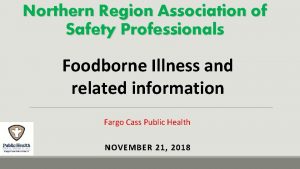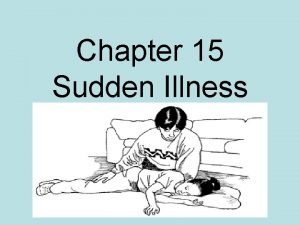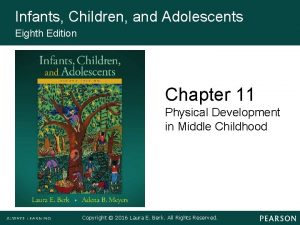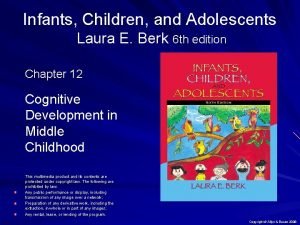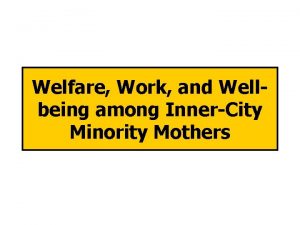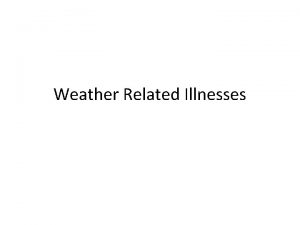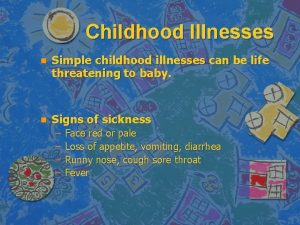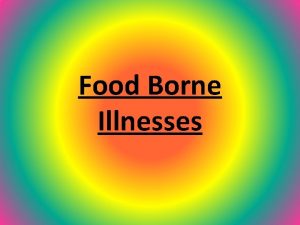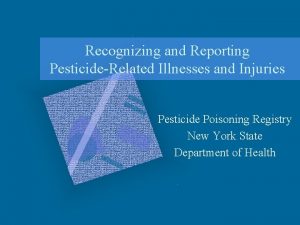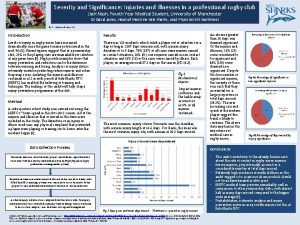ILLNESSES INJURIES AND HOSPITALIZATIONS AMONG INNERCITY MINORITY INFANTS

















- Slides: 17

ILLNESSES, INJURIES, AND HOSPITALIZATIONS AMONG INNER-CITY MINORITY INFANTS IN CHICAGO

Illnesses, injuries and hospitalizations among inner-city minority infants in Chicago Leonidas Margelis, Kaoru Watanabe, Kathleen F. Norr, Kathleen S. Crittenden, & Seijeoung Kim University of Illinois at Chicago We summarize infants’ health problems during the first year, as reported by 763 Medicaid-eligible, minority mothers in inner-city Chicago. Illnesses (in six categories), injuries, and hospitalizations are summarized by neonatal, early and late infancy periods. Predictors include ethnicity, maternal age, parity, education, onset of prenatal care, smoking during pregnancy, baby’s sex and birth cohort, any breastfeeding, and participation in maternal-child advocacy programs. We use t-tests, ANOVA, and OLS regression. The average baby had a total of 3. 05 illnesses, . 13 injuries, and. 18 hospitalizations during the year. Half of the illnesses were respiratory (1. 50), followed by otitis media (OM; . 37), skin (. 35), and gastro-intestinal (GI; . 32). Total illnesses tended to decrease in frequency over the year, as did GI, skin, newborn problems, and other. OM and injuries increased in frequency during the same period. African American and Latino babies did not differ in total illnesses but had different types of illnesses. Skin and respiratory problems were more frequent among African Americans, whereas Latinos had more GI problems and other illnesses. Maternal factors and infant sex did not affect the overall number or types of illnesses. Total illnesses and several illness categories—GI, newborn problems, and other illnesses—declined in frequency across succeeding birth cohorts. Multiple regression analyses indicated that birth cohort and ethnicity independently influenced morbidity. The secular trend toward decreasing frequency of illnesses across birth cohorts may indicate some improvement in health care offered to this vulnerable population. The decline in illnesses by birth cohort parallels the declining infant mortality rates over the same period. Higher illness rates for younger infants are consistent with the higher neonatal than postneonatal mortality rates. There is a need for further research a) to explain ethnic differences in type of infant illnesses and b) to extend the inquiry through the second and third years of the infant’s life. The number and types of infant illnesses can be used to guide low-income parents in inner city neighborhoods. Respiratory problems are the most common illnesses. Safe home management and recognition and appropriate careseeking for complications should be emphasized. Parents also need guidance regarding ear infection, skin problems, and gastrointestinal problems. Injury prevention should be emphasized, especially in the second half of the first year.

Purpose § To describe the number and type of health problems experienced by low income, minority infants from birth to 12 months. § To examine differences in infant outcomes by birth cohort, infant age and gender, and by maternal factors.

Data § Data from two large prospective studies in inner city Chicago were combined, giving a total sample size of 793 infants. § Study I examined infants in a home-visiting program (REACH) without a comparison group. § Study II was a randomized clinical trial of the effect of a similar home visiting program (REACH-Futures) with a control group. § Funded by the Healthy Tomorrows Program, AHCPR, NINR, UIC Medical Center, College of Nursing & Great Cities Institute

Measuring Infant Health Problems § Maternal reports of health problems collected in approximately 5 (Study I) or 3 (Study II) interviews § Measures Ø Total illnesses Ø Illnesses by category: GI, skin, ear infection, respiratory, newborn, other Ø Total injuries Ø Total hospitalizations

Infant Health Problems § Total illnesses: Ø Respiratory: Ø Ear infection: Ø Skin problem: Ø GI: Ø Newborn: Ø Other: 3. 06 per infant 1. 50 0. 37 0. 35 0. 33 0. 06 0. 43 § Total injuries: 0. 13 § Total hospitalizations: 0. 19

Predictors: Mother Characteristics § 76% African American, 24% Latina. § 43% under 20 years old. § 51% high school graduates. § 54% having their first baby. § 50% began prenatal care before 15 th week § 7% ever smoked during pregnancy § 30% ever breastfed their babies.

Predictors: Infant Characteristics § Age: neonatal, early and late post-neonatal § Birth cohort: 1990 -1992 (35%) 1993 -1994 (30%) 1995 -1996 (35%) § Infant sex: 51% Male § Received intervention: 72%

Analyses and Results § T-tests and ANOVA; Multiple regression § Frequency and type of health problems varied by age of the infant. § Both birth cohort and race/ethnicity had direct effects on total illnesses and some specific illness categories, without any interaction effects. § Other maternal and infant factors did not have sufficient effects to remain in the final equation.

Infant Age and Health Problems § To compare illnesses in 3 periods -- neonatal (birth to 28 days), early (2 -6 M) and late (7 -12 M) post-neonatal, we standardized the number of illnesses per 4 -week period. § Neonates had the most frequent health problems and hospitalizations overall. § Ear infections, respiratory problems, and injuries increased in frequency as the infant grew older. § All other health problems were less frequent for older infants.

Birth Cohort and Health Problems § Health problems have declined slightly but significantly over time, consistent with declining overall infant mortality from 1990 to 1996. § Several illness categories declined significantly over time: GI, newborn, and other.

Birth Cohort and Race/Ethnicity § African-American and Latino infants did not differ in overall morbidity and injuries, but they differed in illness categories. § African-American infants had more frequent skin and respiratory problems. § Latino infants had more GI problems.

Infant health problems were not related to: § Maternal demographic factors, including age, parity, and education. § Maternal behavioral factors, including early versus late prenatal care, any prenatal smoking, and any breast feeding. § Infant sex.

Discussion § These low-risk, low income infants were fairly healthy (averaging three illnesses per year), although comparable data are not available for middle class infants. § The race/ethnicity differences in types of illnesses warrant further research.

Measurement Issues § Maternal report of health problems Øis subject to recall bias, so that more recent and more serious illnesses are most likely to be reported. Øincludes illnesses not seen at the clinic. § Comparisons with medical records for 30 cases found all but 2 mothers correctly reported all illnesses seen at the clinic, emergency room or hospital. § Studies I and II had very similar total illnesses per infant and types of health problems, increasing confidence in comparability and reliability.

Infant Morbidity vs. Mortality § The slight decline in illnesses by birth cohort parallels the declining infant mortality rates over the same period. § Higher illness rates for younger infants are consistent with the higher neonatal than post-neonatal mortality rates. § Race/ethnicity, maternal education, age, prenatal care and infant sex did not relate to total health problems, in contrast to mortality patterns for these variables. § The relative homogeneity of this low-income, inner city, minority sample may relate to the lack of effects of maternal factors on infant health problems.

Implications 1. The number and types of infant illnesses by age and race/ethnicity can be used to guide low-income parents in inner city neighborhoods and their health space care providers. 2. Respiratory problems account for half of all infant illnesses. Safe home management and care-seeking should be emphasized. 3. Parents need guidance regarding prevention and management of common infant health problems. 4. Injury prevention should be emphasized, especially in the second half of the first year.
 Strickler spine and sport
Strickler spine and sport Big 6 illnesses
Big 6 illnesses Sudden illness examples
Sudden illness examples Infants and children 8th edition
Infants and children 8th edition Infants children and adolescents 8th edition
Infants children and adolescents 8th edition Creative curriculum intentional teaching cards
Creative curriculum intentional teaching cards Infants, children, and adolescents 8th edition
Infants, children, and adolescents 8th edition Infants and children 8th edition
Infants and children 8th edition Majority and minority carriers
Majority and minority carriers Minority dialect
Minority dialect Doctoral initiative on minority attrition and completion
Doctoral initiative on minority attrition and completion Unit 15:10 providing first aid for specific injuries
Unit 15:10 providing first aid for specific injuries Chapter 28 head and spine injuries
Chapter 28 head and spine injuries Chapter 21 caring for head and spine injuries
Chapter 21 caring for head and spine injuries Injuries to muscles and bones chapter 15
Injuries to muscles and bones chapter 15 Chapter 14 promotion of safety
Chapter 14 promotion of safety Jones and bartlett learning
Jones and bartlett learning Chapter 13:2 preventing accidents and injuries
Chapter 13:2 preventing accidents and injuries

